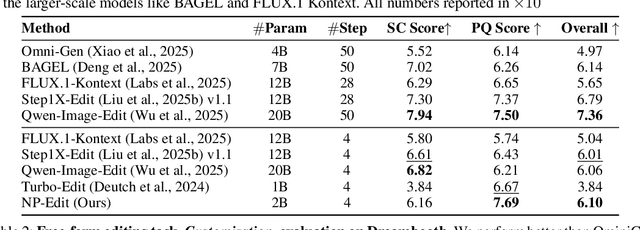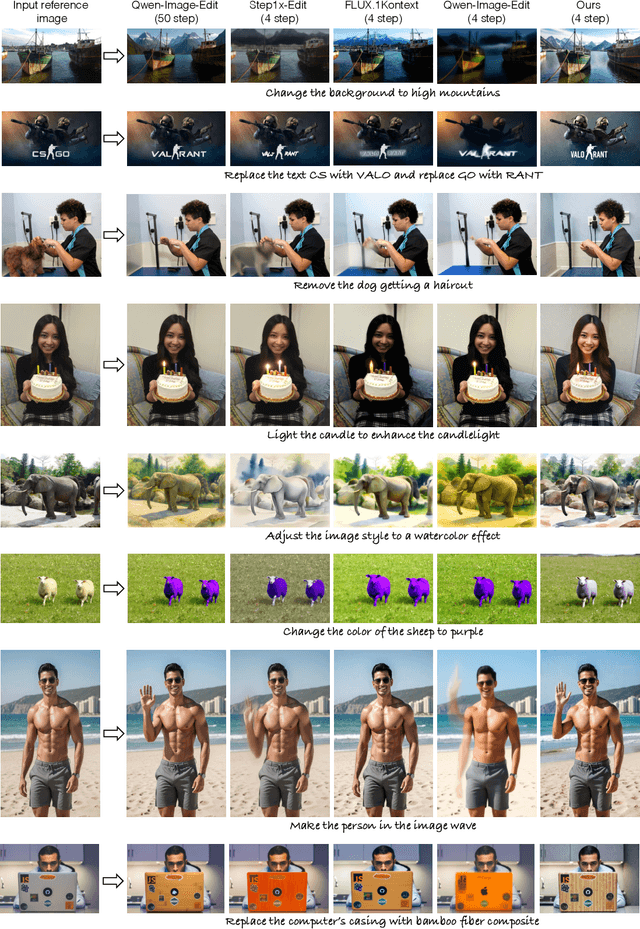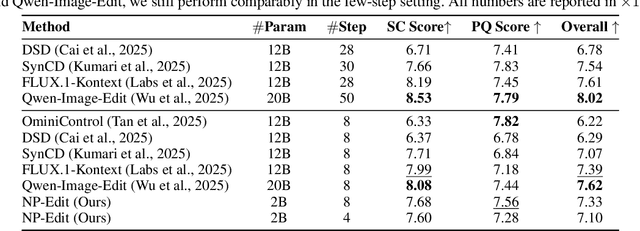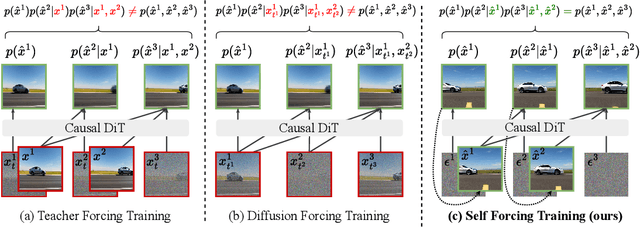Eli Shechtman
Self-Evaluation Unlocks Any-Step Text-to-Image Generation
Dec 26, 2025Abstract:We introduce the Self-Evaluating Model (Self-E), a novel, from-scratch training approach for text-to-image generation that supports any-step inference. Self-E learns from data similarly to a Flow Matching model, while simultaneously employing a novel self-evaluation mechanism: it evaluates its own generated samples using its current score estimates, effectively serving as a dynamic self-teacher. Unlike traditional diffusion or flow models, it does not rely solely on local supervision, which typically necessitates many inference steps. Unlike distillation-based approaches, it does not require a pretrained teacher. This combination of instantaneous local learning and self-driven global matching bridges the gap between the two paradigms, enabling the training of a high-quality text-to-image model from scratch that excels even at very low step counts. Extensive experiments on large-scale text-to-image benchmarks show that Self-E not only excels in few-step generation, but is also competitive with state-of-the-art Flow Matching models at 50 steps. We further find that its performance improves monotonically as inference steps increase, enabling both ultra-fast few-step generation and high-quality long-trajectory sampling within a single unified model. To our knowledge, Self-E is the first from-scratch, any-step text-to-image model, offering a unified framework for efficient and scalable generation.
What matters for Representation Alignment: Global Information or Spatial Structure?
Dec 11, 2025Abstract:Representation alignment (REPA) guides generative training by distilling representations from a strong, pretrained vision encoder to intermediate diffusion features. We investigate a fundamental question: what aspect of the target representation matters for generation, its \textit{global} \revision{semantic} information (e.g., measured by ImageNet-1K accuracy) or its spatial structure (i.e. pairwise cosine similarity between patch tokens)? Prevalent wisdom holds that stronger global semantic performance leads to better generation as a target representation. To study this, we first perform a large-scale empirical analysis across 27 different vision encoders and different model scales. The results are surprising; spatial structure, rather than global performance, drives the generation performance of a target representation. To further study this, we introduce two straightforward modifications, which specifically accentuate the transfer of \emph{spatial} information. We replace the standard MLP projection layer in REPA with a simple convolution layer and introduce a spatial normalization layer for the external representation. Surprisingly, our simple method (implemented in $<$4 lines of code), termed iREPA, consistently improves convergence speed of REPA, across a diverse set of vision encoders, model sizes, and training variants (such as REPA, REPA-E, Meanflow, JiT etc). %, etc. Our work motivates revisiting the fundamental working mechanism of representational alignment and how it can be leveraged for improved training of generative models. The code and project page are available at https://end2end-diffusion.github.io/irepa
Group Diffusion: Enhancing Image Generation by Unlocking Cross-Sample Collaboration
Dec 11, 2025Abstract:In this work, we explore an untapped signal in diffusion model inference. While all previous methods generate images independently at inference, we instead ask if samples can be generated collaboratively. We propose Group Diffusion, unlocking the attention mechanism to be shared across images, rather than limited to just the patches within an image. This enables images to be jointly denoised at inference time, learning both intra and inter-image correspondence. We observe a clear scaling effect - larger group sizes yield stronger cross-sample attention and better generation quality. Furthermore, we introduce a qualitative measure to capture this behavior and show that its strength closely correlates with FID. Built on standard diffusion transformers, our GroupDiff achieves up to 32.2% FID improvement on ImageNet-256x256. Our work reveals cross-sample inference as an effective, previously unexplored mechanism for generative modeling.
Relational Visual Similarity
Dec 08, 2025Abstract:Humans do not just see attribute similarity -- we also see relational similarity. An apple is like a peach because both are reddish fruit, but the Earth is also like a peach: its crust, mantle, and core correspond to the peach's skin, flesh, and pit. This ability to perceive and recognize relational similarity, is arguable by cognitive scientist to be what distinguishes humans from other species. Yet, all widely used visual similarity metrics today (e.g., LPIPS, CLIP, DINO) focus solely on perceptual attribute similarity and fail to capture the rich, often surprising relational similarities that humans perceive. How can we go beyond the visible content of an image to capture its relational properties? How can we bring images with the same relational logic closer together in representation space? To answer these questions, we first formulate relational image similarity as a measurable problem: two images are relationally similar when their internal relations or functions among visual elements correspond, even if their visual attributes differ. We then curate 114k image-caption dataset in which the captions are anonymized -- describing the underlying relational logic of the scene rather than its surface content. Using this dataset, we finetune a Vision-Language model to measure the relational similarity between images. This model serves as the first step toward connecting images by their underlying relational structure rather than their visible appearance. Our study shows that while relational similarity has a lot of real-world applications, existing image similarity models fail to capture it -- revealing a critical gap in visual computing.
UniSER: A Foundation Model for Unified Soft Effects Removal
Nov 18, 2025Abstract:Digital images are often degraded by soft effects such as lens flare, haze, shadows, and reflections, which reduce aesthetics even though the underlying pixels remain partially visible. The prevailing works address these degradations in isolation, developing highly specialized, specialist models that lack scalability and fail to exploit the shared underlying essences of these restoration problems. While specialist models are limited, recent large-scale pretrained generalist models offer powerful, text-driven image editing capabilities. while recent general-purpose systems (e.g., GPT-4o, Flux Kontext, Nano Banana) require detailed prompts and often fail to achieve robust removal on these fine-grained tasks or preserve identity of the scene. Leveraging the common essence of soft effects, i.e., semi-transparent occlusions, we introduce a foundational versatile model UniSER, capable of addressing diverse degradations caused by soft effects within a single framework. Our methodology centers on curating a massive 3.8M-pair dataset to ensure robustness and generalization, which includes novel, physically-plausible data to fill critical gaps in public benchmarks, and a tailored training pipeline that fine-tunes a Diffusion Transformer to learn robust restoration priors from this diverse data, integrating fine-grained mask and strength controls. This synergistic approach allows UniSER to significantly outperform both specialist and generalist models, achieving robust, high-fidelity restoration in the wild.
Learning an Image Editing Model without Image Editing Pairs
Oct 16, 2025



Abstract:Recent image editing models have achieved impressive results while following natural language editing instructions, but they rely on supervised fine-tuning with large datasets of input-target pairs. This is a critical bottleneck, as such naturally occurring pairs are hard to curate at scale. Current workarounds use synthetic training pairs that leverage the zero-shot capabilities of existing models. However, this can propagate and magnify the artifacts of the pretrained model into the final trained model. In this work, we present a new training paradigm that eliminates the need for paired data entirely. Our approach directly optimizes a few-step diffusion model by unrolling it during training and leveraging feedback from vision-language models (VLMs). For each input and editing instruction, the VLM evaluates if an edit follows the instruction and preserves unchanged content, providing direct gradients for end-to-end optimization. To ensure visual fidelity, we incorporate distribution matching loss (DMD), which constrains generated images to remain within the image manifold learned by pretrained models. We evaluate our method on standard benchmarks and include an extensive ablation study. Without any paired data, our method performs on par with various image editing diffusion models trained on extensive supervised paired data, under the few-step setting. Given the same VLM as the reward model, we also outperform RL-based techniques like Flow-GRPO.
Identifying Prompted Artist Names from Generated Images
Jul 24, 2025Abstract:A common and controversial use of text-to-image models is to generate pictures by explicitly naming artists, such as "in the style of Greg Rutkowski". We introduce a benchmark for prompted-artist recognition: predicting which artist names were invoked in the prompt from the image alone. The dataset contains 1.95M images covering 110 artists and spans four generalization settings: held-out artists, increasing prompt complexity, multiple-artist prompts, and different text-to-image models. We evaluate feature similarity baselines, contrastive style descriptors, data attribution methods, supervised classifiers, and few-shot prototypical networks. Generalization patterns vary: supervised and few-shot models excel on seen artists and complex prompts, whereas style descriptors transfer better when the artist's style is pronounced; multi-artist prompts remain the most challenging. Our benchmark reveals substantial headroom and provides a public testbed to advance the responsible moderation of text-to-image models. We release the dataset and benchmark to foster further research: https://graceduansu.github.io/IdentifyingPromptedArtists/
Self Forcing: Bridging the Train-Test Gap in Autoregressive Video Diffusion
Jun 09, 2025



Abstract:We introduce Self Forcing, a novel training paradigm for autoregressive video diffusion models. It addresses the longstanding issue of exposure bias, where models trained on ground-truth context must generate sequences conditioned on their own imperfect outputs during inference. Unlike prior methods that denoise future frames based on ground-truth context frames, Self Forcing conditions each frame's generation on previously self-generated outputs by performing autoregressive rollout with key-value (KV) caching during training. This strategy enables supervision through a holistic loss at the video level that directly evaluates the quality of the entire generated sequence, rather than relying solely on traditional frame-wise objectives. To ensure training efficiency, we employ a few-step diffusion model along with a stochastic gradient truncation strategy, effectively balancing computational cost and performance. We further introduce a rolling KV cache mechanism that enables efficient autoregressive video extrapolation. Extensive experiments demonstrate that our approach achieves real-time streaming video generation with sub-second latency on a single GPU, while matching or even surpassing the generation quality of significantly slower and non-causal diffusion models. Project website: http://self-forcing.github.io/
Long-Context State-Space Video World Models
May 26, 2025Abstract:Video diffusion models have recently shown promise for world modeling through autoregressive frame prediction conditioned on actions. However, they struggle to maintain long-term memory due to the high computational cost associated with processing extended sequences in attention layers. To overcome this limitation, we propose a novel architecture leveraging state-space models (SSMs) to extend temporal memory without compromising computational efficiency. Unlike previous approaches that retrofit SSMs for non-causal vision tasks, our method fully exploits the inherent advantages of SSMs in causal sequence modeling. Central to our design is a block-wise SSM scanning scheme, which strategically trades off spatial consistency for extended temporal memory, combined with dense local attention to ensure coherence between consecutive frames. We evaluate the long-term memory capabilities of our model through spatial retrieval and reasoning tasks over extended horizons. Experiments on Memory Maze and Minecraft datasets demonstrate that our approach surpasses baselines in preserving long-range memory, while maintaining practical inference speeds suitable for interactive applications.
X-Fusion: Introducing New Modality to Frozen Large Language Models
Apr 29, 2025Abstract:We propose X-Fusion, a framework that extends pretrained Large Language Models (LLMs) for multimodal tasks while preserving their language capabilities. X-Fusion employs a dual-tower design with modality-specific weights, keeping the LLM's parameters frozen while integrating vision-specific information for both understanding and generation. Our experiments demonstrate that X-Fusion consistently outperforms alternative architectures on both image-to-text and text-to-image tasks. We find that incorporating understanding-focused data improves generation quality, reducing image data noise enhances overall performance, and feature alignment accelerates convergence for smaller models but has minimal impact on larger ones. Our findings provide valuable insights into building efficient unified multimodal models.
 Add to Chrome
Add to Chrome Add to Firefox
Add to Firefox Add to Edge
Add to Edge